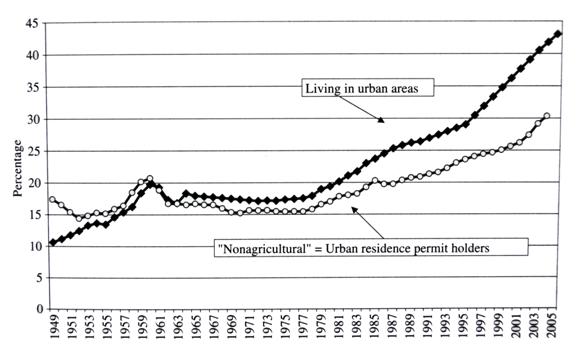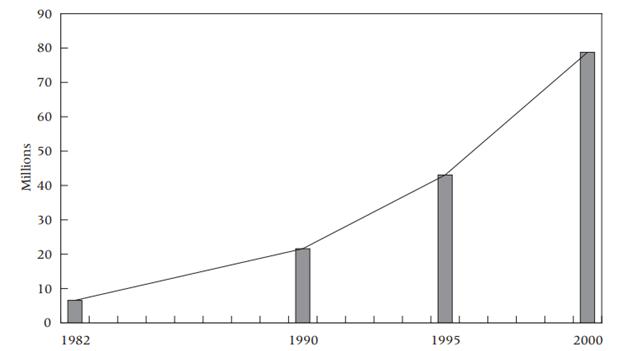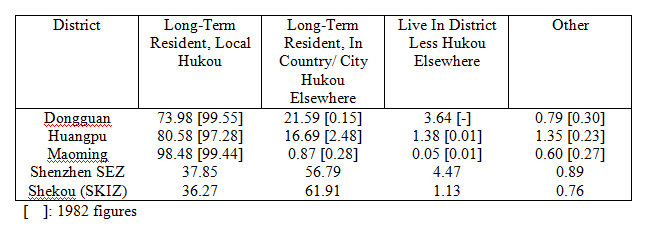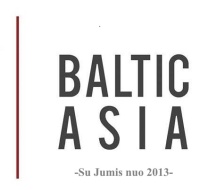Household Registration System
Even though today it is considered to be a very controversial topic, the household registration (hukou) system was inevitable in China. Population registration was necessary, because the country could not afford to offer the social benefits to those who were not in the danwei (work unit) system, and cities could not hold too many people without having social and political upheavals. “In the years immediately after 1949 and during the first Five Year Plan in 1953, peasants flocked to the cities, heeding the call to help in reconstruction and industrialization of economy” [1]. Implemented in the late 1950s by the Chinese Communist Party, the household registration system was a result of command economy and therefore benefited China in numerous ways, but has been obstructing many people ever since. It led to the country having an officially acknowledged divisive socioeconomic structure and three castes of society. Although the system was created for the purpose of “tracking down” the changes of figures of population, it has also influenced the internal migration in China in many ways. This article will look into how the household registration (hukou) system influenced China’s rural-to-urban migration and what effects it had on China’s social and urban development.
Introduction of the Hukou System
The most obvious effect on rural-to-urban migration was also the main goal of the hukou system – the undesirable migratory flows were tightly controlled and almost stopped for several decades. When farmers were made to sell grains for the government at artificially low prices, it was essential to keep them tied to the land: “the purpose was not merely to monitor population movements, but to anchor people to their native places, and – in particular – to prevent unauthorised movement from the countryside to the city” [2]. “By 1957, the problem of ‘blind influx’ into China’s cities finally brought the intervention of the highest bodies of Party and state, with the Central Committee and the State Council issuing a joint directive exhorting tighter controls over migrants” [3]. As a result, in January 1958, the National People’s Congress passed “more specific regulations intended to put a stop to unauthorised population movements” [4]. People were provided a ‘household registration booklet’, which established a sort of legal identity. The key distinction has been “nongye hukou” (agricultural household status) and “feinongye hukou” (non-agricultural household status). Since the implementation of the household registration system, it became practically impossible to leave the countryside, and internal rural-to-urban migration in China almost ceased to exist.
The newly established hukou system worked in a way so that any kind of migration was strictly controlled, as changing one’s hukou status was extremely difficult. “Individuals could move voluntarily downward (to a smaller city or to a rural place) or horizontally (as when rural brides moved into the homes and villages of their grooms), but not upward” [5]. Permission to migrate upwards was only granted if a person obtained approvals from both origin and destination governments, which happened in relatively rare and special situations, for example, “admission to an urban university, service in and then demobilization from the army as an officer, or in a situation in which an urban factory had taken over rural land for plant expansion” [6]. But such cases were very rare for people living in villages: “in one village in Guangdong, on average only one man was able to change to urban registration every five years. Among women, this was only one every fifty years” [7]. All of the restrictions meant that while cities were officially out of reach for rural people, internal migration could still exist and “free”, even if limited, movement was available to all.
Separation between Rural and Urban Citizens
The household registration system resulted in some 700–800 million people in effect treated as second-class citizens, deprived of the opportunity to settle legally in cities and of access to most of the basic welfare and state-provided services enjoyed by regular urban residents [8], which lead China to de-urbanise. The main legal differences between benefits provided by non-agricultural hukou status were as follows: social insurance (tax and benefit levels differ, so does the access to benefits), local services (access to education, housing and healthcare, rationed food coupons), property rights (allocated housing) and job restrictions (allocated jobs) [9]. As only the non-agricultural hukou status holders had the access to the benefits listed, it meant that agricultural hukou holders could not survive in cities. Hence, once so pursued life in urban areas now meant having no means to obtain food or shelter, or even earn money to purchase mentioned necessities (even if food or land markets had existed, which they did not). This lead to something never seen before: as all developing countries were slowly expanding their urban societies, “between the end of the 1950s and 1978, China de-urbanised” [10], as we can see in figure 1:

Figure 1: Urban share of total population
The data in the chart portrays the most important effect of the hukou system: the internal migration to cities was stopped and the urban share of the population declined by more than two percentage points. This proves that the plan to reduce urban population worked almost flawlessly in the first few years from its implementation.
Although the costs of changing one’s status were high, there continued to be a very high level of undocumented migration in China. During the years of the Great Leap Forward and the famine that followed, having a non-agricultural hukou status was a ticket to life. As millions of people did not have the possibility to change their household registration status, they decided to try their luck illegally moving to cities, even though they had to face lots of hardships: illegal labour was poorly-paid and migrants had to rely on their family members back in the villages for grain (in addition, even though officially outlawed as dangerous vestiges of capitalism, there were also black markets in cities). The Chinese government was happy with the “perfectly running” plan, but in reality, there was a fairly intense movement happening behind their backs: “in addition to the estimated 30 million who migrated to the cities during the Great Leap Forward (20 million of whom were forcibly returned), an estimated 4 million voluntarily migrated during the first two years of the Cultural Revolution when state control was relatively weak” [11]. Therefore it can be stated that, even though the hukou system made internal migration much harder, the phenomenon of rural-to-urban migration itself never stopped existing.
Hukou System Reformed
As the household registration system was changed and restrictions relaxed within the years, the third caste appeared in society. In 1978, when the opening reforms began, the Chinese officials eventually realised they needed more labour force to continue the process of intensive industrialisation. Within the years that followed, more and more rural hukou holders were taken to the cities for manual labour, which meant that the household registration system needed to be relaxed. “From 1979 to 1995 the nonagricultural hukou population grew at an average of 7.8 million per year, or 3.7%, compared to an average of 2.5 million or 1.9% per year in the period between 1963 and 1978” [12]. When analysing the causes of this change, it is worth noting that the Chinese government was not the main initiator of liberalisations. The government was responding and adapting to the situation that was already changing from the ground, the massive flows of people trying to get into cities. During the 1960s and 1970s, especially after Mao’s 1968 order, about 17 million urban youth were sent “up to the mountains and down to the villages”. But when around 1975 they began coming back from the villages, “article 90, guaranteeing freedom of movement, was removed from the new constitution of the PRC” [13]. The educated youth did not give up, and won the battle against the CCP: “after the Party’s Third Plenum of 1978, the returned youths petitioned the authorities to restore urban residential rights, putting up posters, organizing demonstrations and sit-ins, and disrupting rail traffic. In 1979, the great majority were allowed to return to their home cities or at least restored to “non-agricultural” status in local towns in a brilliant example of successful resistance to the state by a well-organized and determined group” [14].
Another reason why the Chinese government loosened the measures of the urban growth control was a “growing rural prosperity arising directly from the decision to abolish the collective system of rural work and remuneration” [15]. Together with these masses of (no longer young) returned city dwellers, more and more rural people were seeking jobs in the construction trades in urban areas. Cities’ governments took many of them in as cheap labour force and gave temporary non-agricultural household registration statuses, but did not provide any of the social benefits that were offered to urban hukou holders. Therefore, it is worth noting that the relaxations of the household registration system created a third caste in the Chinese society; in addition to rural residents and urban hukou holders, rural-urban migrants appeared, also called the “floating population”. As the intermediate caste in this conception, migrants were having access to many more opportunities than the rural kin they had left behind. However, on many different fronts they were subject to inferior treatment and discrimination by both urban hukou holders and urban authorities, no matter how long they had been a de facto urban resident [16]. Despite being employed in urban areas, migrants have been vulnerable to police arrest, physical abuse, detention, and deportation to their native village, especially if they were unable to present proof of at least temporary urban registration.
This situation changed a little in 1985, when a new law introduced temporary residence permits (zanzhuzheng) that legalised the status of rural migrants in cities. The main requirements to obtain the right to live in cities were that the migrants “must either run businesses or be employed in enterprises, and have own accommodations in market towns. They must also self-provide their own food grain” [17]. After that, town and city governments realised that selling permanent hukou to those that could afford it was a good source of income: “One of the first towns to do so, Laian, in Anhui, sold 773 permits at 5,000 yuan apiece in just six days” [18]. Figure 2 shows how the number of the so-called “floating migrants” increased from 1985 to 2000:

Figure 2: Growth of the intercounty floating population in China
Starting with only 7 million floating residents in 1982, by 2000 the number of temporary migrants reached almost 80 million. “Generally, the size of the rural migrant labor grew from about 50-60 million in the early 1990s to exceed 100 million in the early years of this century. In 2009, the figure was close to 150 million” [19]. This means that the rapid increase continues to this day and the number of floating migrants has multiplied more than 20 times from 1982 to 2009. The figures prove that in general, the population has been more mobile in the reform era than ever before.
The Real Effect of the Hukou System
But what did having a chance to move again mean? The hukou system started to indirectly promote pursuing a life in urban areas, because before the household registration system, not only the population could move freely, but one’s social status remained untouched. After the implementation of hukou system, being able to change location meant being inferior to the local people, and having no social benefits: “Since fewer than 3 percent can afford health insurance, most avoid medical care altogether. City judges often impose harsher sentences on rural migrants, and employers frequently withhold wages, knowing undocumented workers cannot complain to police without risking exposure” [20]. The two-caste society that was created had not only socioeconomic effects on migration, but also psychological ones. Some 260 million Chinese migrants — about 20 percent of China’s total population — live as second-class citizens in their adopted cities [21].
The line, or as Southern Weekend newspaper called it, the “electric fence” [22] that originally separated agricultural and non-agricultural hukou status holders, now “effectively lies between official residents of the largest, most prosperous and desirable cities and all others” [23]. The two-tiered society that was a result of the household registration system now enthrones urban status and makes it an ultimate goal for millions of rural residents, who put all their effort in order to obtain the benefits only available to “urbanities” if not for themselves, then at least for their children. By not providing equal rights to all urban citizens, hukou restrictions indirectly promote migration and striving for a legal status that ensures less dangerous job with a better wage, a pension, and healthcare provided by the employer [24] [25]. People’s rights are being violated – for example, in 2000 over three-quarters of all child-birth deaths in Canton were of migrant women [26], as their admission to the hospitals was refused. As there are greater chances to earn enough money to afford healthcare and other necessities in cities rather than in rural areas, it can be stated that household registration system drives massive crowds of (especially young) people to cities to try and seek for a better life, and therefore promotes China’s internal migration.
Another thing the household registration system (together with the wave of migration that came with it) influenced, was urbanisation. Some areas, especially those on the coastline, grew so much that their demographic profiles were affected. From a relatively small town some cities grew into metropolises in just a couple of years, all thanks to rural migrants, who in some places take up a bigger share of population than the locals (see Figure 3):

Figure 3: Hukou Status by Category (in %).
The data shows that by 1990 in some industrial regions there were more agricultural hukou status holders than local citizens. “Rural–urban migration turns out to be the dominant source of Chinese urban growth in 1978–1999. In the two decades since 1978, about 174 million people (more than total population of many large countries in 1998, such as Brazil with 166 million and Russia with 147 million) have moved from rural areas to cities, creating the history’s largest flow of migration in the world” [27]. This has led to cities expanding and China rapidly urbanising, even though most urban residents live in poverty and do not have many legal rights.
Concluding Remarks
To summarise, the household registration system could not be avoided in a country such as China, because cities could not hold and provide for too many people. For some time the hukou system stopped internal migration to cities, but since the rural areas were facing hardships and even famine, illegal migration continued to exist. Eventually, after the opening reforms, the household registration system was relaxed. Even though this resulted in getting many people out of poverty, equal rights and social benefits are still not provided for millions of Chinese residents, and it is becoming more and more of a problem. Having the right to live in a city does not mean one is equal to those with an approved registration status, and the hukou system influences migration in a way that it develops desire of people to be in the better caste, which results in many people at least attempting to migrate and succeed in cities. Therefore, it can be said that the hukou system is a vicious circle, helping the country economically but dragging it down in terms of social equality.
Written by: Greta Oss
Edited by: Monika Dvirnaitė
Additional information
Photos:
- Atlaslin: Hukou certificate of P.R.C.
- Charlie fong: 2009 Chunyun period,Beijing West Railway Station,China
Footnotes:
- Eichen and Zhang, 1992.
- Kirkby, 1985.
- Renmin Ribao, 1957.
- New China News Agency, 1958.
- Whyte, 2010.
- Chan, 2009.
- Potter, 1983.
- Chan, 2010.
- Kuhn, and Shen, 2013.
- Naughton, 2006.
- Yang, 1994.
- Ministry of Public Security, 1991.
- Nyíri, 2010.
- Perry and Selden, 2003.
- Kirkby, 1985.
- Whyte, 2010.
- Zhu, 1991.
- Wei, 2001.
- Chan, 2008.
- Edkins, 2010.
- Zhang and Song, 2003.
- Li, 2003.
- Nyíri, 2010.
- Luan, 2000.
- Zhao, 2003.
- Human Rights in China, 2002.
- Zhang and Song, 2003.
References:
- Chan Kam Wing (2009), “The Chinese hukou system at 50”, Eurasian Geography and Economics 50(2): 197–221.
- _____(2010), “The Household Registration System and Migrant Labor in China: Notes on a Debate”, Population and Development Review, June 36 (2): 357.
- _____(2013), “China, Internal Migration,” in Immanuel Ness and Peter Bellwood (eds.) The Encyclopedia of Global Migration, Blackwell Publishing.
- Edkins, B (2010), “China’s Undocumented Migrant Problem” Slate Magazine, available at http://www.slate.com/articles/news_and_politics/foreigners/2010/05/chinas_undocumented_migrant_problem.html [8 December, 2013].
- Eichen, M. and Zhang Ming (1992), “Internal Migration in the People Republic of China”, Focus On Geography 42: 20.
- Guldin, G. E. (2001), What’s a Peasant to Do? Village Becoming Town in Southern China, Colorado: Westview Press.
- Human Rights in China (2002), INSTITUTIONALIZED EXCLUSION: The tenuous legal status of internal migrants in China’s major cities, November 6.
- Kirkby, R. J. R. (1985), Urbanisation in China: Town and Country in a Developing Economy 1949 – 2000 AD, Worcester: Billing & Sons Limited.
- Kuhn, P., Shen, K. (2013), “Do Employers Prefer Undocumented Workers? Evidence from China’s Hukou System”, Impacts of Hukou, Education and Wage on Job Search and Match: Evidence Based on Online Job Board Microdata 107: 15.
- Li Changping (2003), “Huji zhidu de yanbian” (The transformations of the hukou regime), Nanfang Zhoumo, 3 April.
- Liang Zai and Ma Zhongdong (2004), “China’s Floating Population: New Evidence from the 2000 Census”, Population and Development Review 30(3): 467.
- Luan Jingdong (2000), “Fada diqu nongcun wailai laodongli he yimin guanli yanjiu” (A study of outside labour and migrant management in villages in developed regions), a PhD dissertation, Turku University.
- Ministry of Public Security (1991), “Guanyu zhuanfa bufen shengshi hukou nongzhuanfei gongzuo zuotanhui jiyao de tongzhi” (On Circulating the Minutes of the Working Forum Concerning Hukou Transfer from Agricultural to Non-agricultural Status), May 4.
- Naughton, B. (2006), The Chinese Economy: Transitions and Growth, Cambridge, Massachusetts: The MIT Press.
- New China News Agency (1958) January 9: 2, in Orleans, L. (1959), “The Recent Growth of China’s Urban Population”, Geographical Rewiev 49: 53.
- Nyíri, P. (2010), Mobility and Cultural Authority in Contemporary China, Seattle: University of Washington Press.
- Perry, E. J., Selden, M. (2003), Chinese Society: Change, Conflict and Resistance, Oxford: Taylor and Francis.
- Population Research Institute, Chinese Academy Social Science (1996), Zhongguo renkou nianjian 1996 (Almanac of China’s Population 1996), Beijing: Zhongguo minhang chubanshe.
- Potter, S. H. (1983), “The Position of Peasants in Modern China’s Social Order”, Modern China, 9:4.
- Renmin Ribao (1957), “Directive for checking the blind outflow of the rural populations”, December 9, 260-1.
- Wei Jun (2001), “Feichu hukou!!!” (Get rid of the hukou!!!), Zhongguo Shehui Daokan 4:21.
- Whyte, M. K. (ed.) (2010), One Country, Two Societies: Rural-Urban Inequality in Contemporary China, Massachusetts: Harvard University Press.
- Yang Yunyan (1994), Zhongguo renkou zhuanyi yu fazhan di changqi zhanlüe (Migration and long-term development strategy in China), Wuhan: Wuhan Chubanshe.
- Zhang, Kevin Honglin and Song, Shunfeng (2003), “Rural–urban migration and urbanization in China: Evidence from time-series and cross-section analyses”, China Economic Review, 14:4.
- Zhao Jin (2003), “Jiangsu huji gaige lengqing kaichang” (Jiangsu hukou reform proceeds calmly), Zhongguo Jingji Shibao, 19 May.
- Zhu, Baoshu (1991), “Nongcun renkou xian shaochengzhen zhuanyi de xindongtai hexinwenti” (New Situation and New Problems Concerning Rural Population Migrating to Small Towns), Zhongguo renkou kexue 1:49.
